 Facebook
Facebook
 X
X
 Instagram
Instagram
 TikTok
TikTok
 Youtube
Youtube
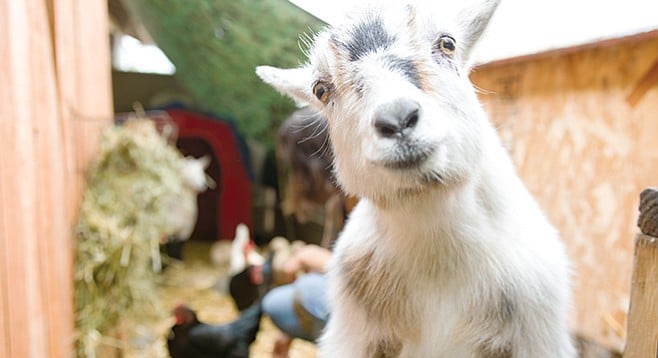

“So, the whole of my front yard is 100 percent edible,” says Jeri. "There’s not one thing — not even the hibiscus, which can be used for tea — that is not edible. I have fruit trees: lemon, lime. I have tomatoes, kale, cilantro, chard. We’re on our winter crop right now, so we have beets, celery root, and lettuce.”
Incorporating a little farming into our suburban lives has become fashionable — but the scale of Jeri’s farm is difficult to imagine — or commit to — especially given the unaccommodating zoning for her suburban Chula Vista street. But, it’s Jeri’s reason for cultivating this small farm that is the real story.
At the age of two, Jeri’s son, Soren, didn’t speak or make eye contact. “I was in denial, but my partner Brian [Soren’s father] kept saying, ‘There is something wrong with Soren.’
“We took Soren to the San Diego Regional Center — a place that provides services for people with disabilities — and they tested him but said they wouldn’t give him an actual diagnosis at that age. Then they started therapy treatment for Soren and a year later, at three, he was re-evaluated and they diagnosed him as autistic with an extreme BS speech delay.
“I was honestly in shock. I said, ‘This test is b.s., this is not real’ — denial, I think, is a mom’s protection. But as soon as I got out of that, I was, like, how do we fix this? A lot of people say, “It is what it is.” No. It’s not. I kind of say that Facebook saved my son, because I just got on Facebook and started reading people’s blogs trying to figure out what to do.”
The number of children diagnosed with autism has steadily risen in the past ten years. The Centers for Disease Control defines Autism Spectrum Disorder “as a group of developmental disabilities that can cause significant social, communication, and behavioral challenges.” The center says that 1 in 68 children has been identified with Autism Spectrum Disorder, and though it can occur in any country, race, or gender, it is five times more common among boys.
“We put Soren in pre-school when he was first diagnosed, without letting the school know he had a diagnosis. We wanted to see what people that deal with kids all the time said about him. When the preschool addressed it with us — they said he couldn’t be in school without a full-time aide.”
During this time, Jeri searched for a way to cure Soren.
“There was a big movement about gluten-free, dairy-free diets for autistic kids. So, I’m thinking, Let’s just try this. Brian actually has celiac disease” — acute gluten allergy — “so there was a very good chance that Soren had it. We went gluten-free and dairy-free and within three weeks my son looked at me and spoke. From there we just started going down a rabbit hole, and the more research and changes we made, the more Soren improved.
“My son is unique. He has had stomach issues his whole life. He gets a rash on his body when he can’t process foods. It’s a sign to me. It clears up when we’re doing the right things.
“We did away with anything out of a can, no colorings, no msg, no preservatives. We changed our house water, we changed our drinking water, we did extensive vitamin-mineral cleanses, detoxifications...there’s a couple more things we want to do — unfortunately, the only thing that hinders us is cost. Insurance doesn’t cover anything. These doctors that we have, like the homeopathic one in London, insurance won’t even touch them. Chiropractic costs alone are close to $2000 a year.
“Some people think I’m crazy, but the majority of people I’ve come in contact with, if they go gluten-free, dairy-free, they see a change in their child. It floors me that more parents aren’t willing to try it.
“It’s hard, but what do you have to lose? Put all your food in Tupperware containers, put it away for 30 days, go 100 percent clean for your child. They might cry or whine, you may have to be in the kitchen longer, but see if it makes a difference. We’ve decided to do it as a family, as a unit, and that makes it easier, and we’ve all gotten healthier.”
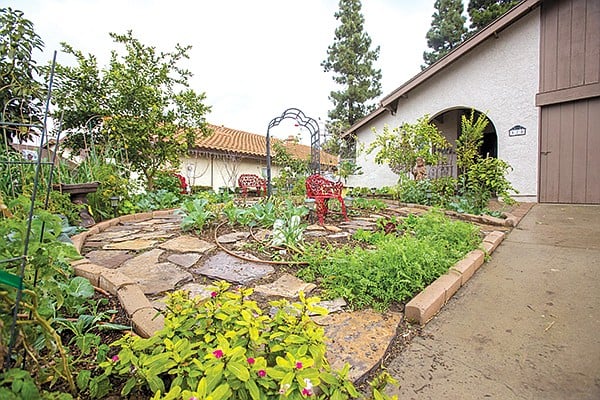
As Jeri began to see the results in Soren, she increasingly transformed the family yard into a farmyard. I first noticed her front yard on a summer walk. The whole yard, every inch was used purposely. It was like looking at a contradiction — it was exuberant and lush, yet orderly.
There were squash blossoms as big as elephant ears, and Jeri was spraying something on them. My squash always does a mildew meltdown by late summer, so I wanted to know her secret.
“It’s a mixture of baking soda and water,” she said. “It’s the only thing that works on the mold these plants get.”
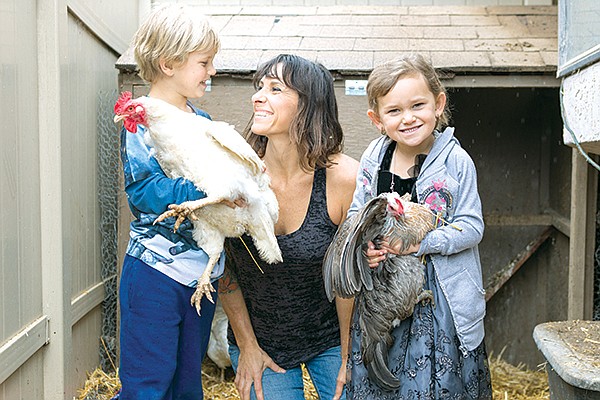
I asked her how she amends her soil to grow such stunning plants and she invited my husband and I into the back yard. Inside the house was a little girl who was about two — her daughter Josie — standing in the kitchen munching on a carrot. Through the sliding-glass doors leading to the back yard, I glimpsed a tropical retreat — there was a pool, a hot tub, and a hammock strung between two trees. Where was the farm?
We went outside and Jeri explained the layout: “The back yard is where I have all my tropical fruit — mango, papaya, and passion fruit. On one side of the house I have my beehive and over on that side I also have all my potatoes in barrels. It’s a really interesting way to grow your potatoes. They’re all in bins or barrels and they just keep growing. At the end of the day, you put a tarp down and flip over your barrel, you sort through the potatoes or sweet potatoes and put all your dirt back in your barrel and start over.
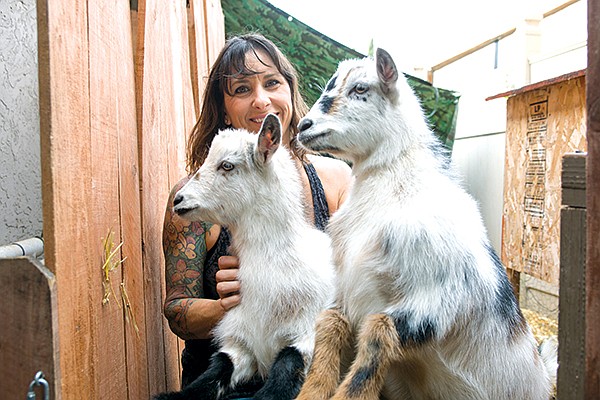
“I have a quail hutch with nine quail. I have six meat birds in the back, two dwarf Nigerian goats, one which will get pregnant next year so she’ll produce half a gallon a day. Then we have three rabbits, which we’re playing with the idea of breeding and using as sustainable meat.
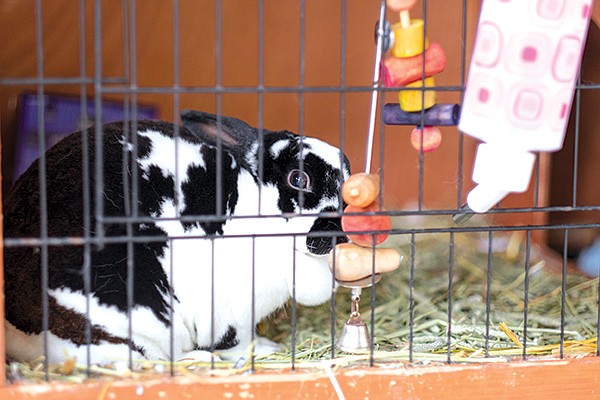
“I’m learning how to be a farmer on a small scale. It’s a big learning curve, and it’s about figuring out the right amount of fertilizer and doing it organic and not creating more of a problem by putting pesticides on the plants and stuff like that. I have a worm bin and a mulch pile as well. We have even rigged our own kind of gray-water system. All of our laundry soap goes into a drum with a pump and that waters the front yard.”
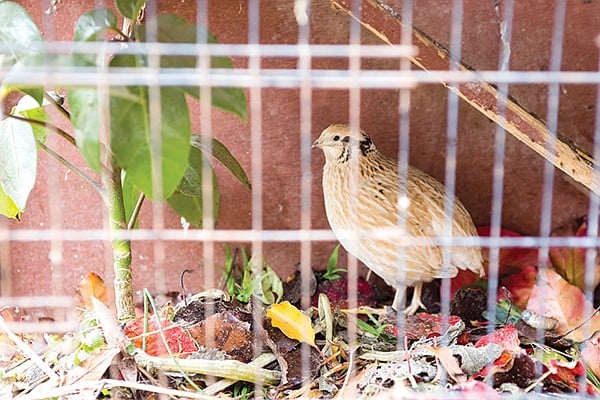
Two dogs dodged around our feet as we walked around the back yard, when Jeri opened a gate that held the 13 laying hens and two goats bounded out angling for their share of attention. It could have been a scene from ta tropical paradise until she said: “We’re going to slaughter the meat birds . The quail are for meat, too.”
When I suggest that she might lose the humanitarian award she was about to receive, she laughs and says: “This is part of being sustainable. The only people who can really judge are people that are vegans, because if you go to a local grocery store and you buy any type of meat you can’t be mad at me. Look at what those poor animals that are on the grocery shelves wrapped in plastic have been put through. It’s insane. They live in their own feces, they never get to see the light of day; they’re fed genetically modified corn and are pumped up with antibiotics and steroids — but, hey, they’re fresh and natural.
“My old captain who got me into farming said, ‘My animals have 364 good days and 1 bad day.’”
What? Old captain? You may have thought Jeri was a woman of leisure with all the time in the world to devote to her family and proliferating farm. In reality, she has so little time that some of our conversation had to take place at the North County fire station, where Jeri works 300 hours a month as a fire engineer and rescue worker. Her partner Brian is a fire captain.
“Becoming a firefighter was intense. It’s your own preparation prior to being accepted, as far as becoming an EMT [Emergency Medical Technician]. It’s on you, and I was going to school to become a paramedic. When you get hired, they put you through four months of training, six days a week. You train all day, go home and study at night, and get up and do it again.”
Sometimes, Jeri says, she finds time to bake for her family at the station, although so far, through 11 months of 2015, her station responded to 142 fires, 1202 medical calls, 152 emergency medical calls, 21 rescues…and so on; 1767 incidents in total.
I asked Jeri, how does doing so much affect your life?
“It is our whole life. Healing our son is our priority. My farm right now is small scale to see if we can do it. It’s a stepping stone. I want to be able to maintain an organic grocery store on my property.
“But we try to find balance. It’s important for us to do special things with our daughter Josie, too, as we spend so much time taking Soren to appointments. And my kids are not deprived: they have treats, they have everything. We’ve learned to cook everything. My kids have cupcakes, cookies, pretzels. I make everything out of nuts, coconut oil, and local honey.
“Brian and I will go to dinner. I was a vegetarian for years, so I’m still asking like the crazy lady, ‘Did the chicken have a good life? Where did it live? Was it grass-fed?’ But we have a good time.”
Generally, children diagnosed with autism do not experience such dramatic improvement as Soren. Autism is viewed as a lifetime developmental disorder. But in 2014 New York Magazine carried an article called “Kids Who Beat Autism.” The article refers to two recent studies, one led by Deborah Fein, a clinical neuropsychologist, and another led by Catherine Lord, a leader in the diagnosis and evaluation of autism.
Although the studies did not involve diet, they both demonstrated that a small percentage of children improved to the point that they “no longer met the criteria for the disorder.” In both studies, early intervention was key, and one study suggested the children who had been given psychotropics were less likely to recover.
Aside from dramatically changing Soren’s diet, Jeri also felt the need to back away from some of the conventional treatment that was offered to Soren.
“Unfortunately, if you go to a normal physician, they’re going to tell you it’s the new normal or they’ll medicate your child. Once they start medicating your child it seems they never get better. Until we started finding the right doctors, we didn’t get the help we needed.
“For example, we took Soren out of therapy. It doesn’t cure everybody; it teaches an awkward child to live in our world. I pulled him out of therapy because he became programmed, and I had to break the programming. He wasn’t freely thinking for himself; he just knew he had to answer in a certain way in order to get his prize, kind of like a dog or an animal, and I know that has been a concern with a lot of parents; therapy is not always beneficial for kids.”
But how do you know that Soren is improving? What proof do you have?
“We retook a test recently that Soren was given when he was first diagnosed. A score from 0 to 180 is extremely autistic. Anything over 100 means there’s a 90 percent chance the child will not be able to care for himself. Anything under 10 is considered not autistic anymore. When Soren was first diagnosed at three he scored 110. Nine months ago he scored a 34, and a couple of weeks ago he scored a 15. So, we’re 5 points away, according to this test.”
But the larger proof of Soren’s progress was in school.
“So, we went from full-time aide to a mild autism class, progressed to a half-and-half classroom, and this year he is in a regular classroom. Teachers now say they see no autism in him at all.”
Though Soren is almost cured, Jeri dreams of helping other children diagnosed with Autism Spectrum Disorder. She hopes one day to buy a large piece of land somewhere in San Diego.

“I want to be self-sustainable and, of course, be able to have enough meat, eggs, and honey for anyone who wants to buy it. But, more than that, I want to run a summer camp for autistic kids. I want it to be 100 percent controlled, so we would have little huts where one parent and a child could stay. It would be a three-month thing.
“When the kids arrive they would take an intake test with a psychiatrist. Then for three months they would mountain-bike ride, dirt-bike ride, play, fish, they would do everything on the property not knowing what we were doing. We would control their water and control their food, just control their environment. While they were having fun, we’d be doing what we could to help them. Three months later the psychiatrist would re-evaluate them. The hope is that we could impact kids’ and parents’ lives in those three months.”
Until she buys the farm, the burning question is zoning.
“Technically, I am not zoned for anything I’m doing. The reason I have the goats is so I can have raw goat milk — which is illegal in California. Yet, raw goat milk has so many great properties and they’ve shown that autistic kids can process it well. I’ve been taking the goats to schools to share with other children and that’s one way of getting a zoning exemption. If you can prove that your goats are being used for educational purposes, then you can keep them.”
What about the beehives?
“No…not supposed to have those, either. But they’re selling bee kits at Costco right now, and they’re selling chicken houses. So, I think things are moving in the right direction.
“And the thing that’s interesting is that Bonita, National City, Imperial Beach — all of the cities surrounding us — allow goats, but not Chula Vista. That’s silly.
“I’ve actually communicated with our neighbors, the ones that are closest to us, and let them know, ‘Hey this is what we’re doing.’ Lots of people — like you — want to see what we’re up to, so I just invite them in and show them.
“Some of our neighbors are ecstatic. The neighbors to the left of me told us to pull all the hedges out and plant fruit trees. So, we’re going to plant ten more trees.”
One neighbor has filed complaints with the city. Jeri says she wishes these were different times when neighbors just talk to each other rather than file complaints. But, according to Jeri, the complaints are not accurate and are even directed at the wrong address.
“This is not your normal HOA picture-perfect home. But many neighbors share the vision. I feel grateful to have some really cool neighbors that understand the bigger picture.” At some point — when she has more free time — Jeri says she wants to start advocating with the Chula Vista City Council to revisit the zoning laws.
As for Soren, he is five years old and his teachers are surprised that he was ever diagnosed with autism.
“We have removed Soren from all autism treatment — it’s time for him to just be a normal little boy.”



“So, the whole of my front yard is 100 percent edible,” says Jeri. "There’s not one thing — not even the hibiscus, which can be used for tea — that is not edible. I have fruit trees: lemon, lime. I have tomatoes, kale, cilantro, chard. We’re on our winter crop right now, so we have beets, celery root, and lettuce.”
Incorporating a little farming into our suburban lives has become fashionable — but the scale of Jeri’s farm is difficult to imagine — or commit to — especially given the unaccommodating zoning for her suburban Chula Vista street. But, it’s Jeri’s reason for cultivating this small farm that is the real story.
At the age of two, Jeri’s son, Soren, didn’t speak or make eye contact. “I was in denial, but my partner Brian [Soren’s father] kept saying, ‘There is something wrong with Soren.’
“We took Soren to the San Diego Regional Center — a place that provides services for people with disabilities — and they tested him but said they wouldn’t give him an actual diagnosis at that age. Then they started therapy treatment for Soren and a year later, at three, he was re-evaluated and they diagnosed him as autistic with an extreme BS speech delay.
“I was honestly in shock. I said, ‘This test is b.s., this is not real’ — denial, I think, is a mom’s protection. But as soon as I got out of that, I was, like, how do we fix this? A lot of people say, “It is what it is.” No. It’s not. I kind of say that Facebook saved my son, because I just got on Facebook and started reading people’s blogs trying to figure out what to do.”
The number of children diagnosed with autism has steadily risen in the past ten years. The Centers for Disease Control defines Autism Spectrum Disorder “as a group of developmental disabilities that can cause significant social, communication, and behavioral challenges.” The center says that 1 in 68 children has been identified with Autism Spectrum Disorder, and though it can occur in any country, race, or gender, it is five times more common among boys.
“We put Soren in pre-school when he was first diagnosed, without letting the school know he had a diagnosis. We wanted to see what people that deal with kids all the time said about him. When the preschool addressed it with us — they said he couldn’t be in school without a full-time aide.”
During this time, Jeri searched for a way to cure Soren.
“There was a big movement about gluten-free, dairy-free diets for autistic kids. So, I’m thinking, Let’s just try this. Brian actually has celiac disease” — acute gluten allergy — “so there was a very good chance that Soren had it. We went gluten-free and dairy-free and within three weeks my son looked at me and spoke. From there we just started going down a rabbit hole, and the more research and changes we made, the more Soren improved.
“My son is unique. He has had stomach issues his whole life. He gets a rash on his body when he can’t process foods. It’s a sign to me. It clears up when we’re doing the right things.
“We did away with anything out of a can, no colorings, no msg, no preservatives. We changed our house water, we changed our drinking water, we did extensive vitamin-mineral cleanses, detoxifications...there’s a couple more things we want to do — unfortunately, the only thing that hinders us is cost. Insurance doesn’t cover anything. These doctors that we have, like the homeopathic one in London, insurance won’t even touch them. Chiropractic costs alone are close to $2000 a year.
“Some people think I’m crazy, but the majority of people I’ve come in contact with, if they go gluten-free, dairy-free, they see a change in their child. It floors me that more parents aren’t willing to try it.
“It’s hard, but what do you have to lose? Put all your food in Tupperware containers, put it away for 30 days, go 100 percent clean for your child. They might cry or whine, you may have to be in the kitchen longer, but see if it makes a difference. We’ve decided to do it as a family, as a unit, and that makes it easier, and we’ve all gotten healthier.”

As Jeri began to see the results in Soren, she increasingly transformed the family yard into a farmyard. I first noticed her front yard on a summer walk. The whole yard, every inch was used purposely. It was like looking at a contradiction — it was exuberant and lush, yet orderly.
There were squash blossoms as big as elephant ears, and Jeri was spraying something on them. My squash always does a mildew meltdown by late summer, so I wanted to know her secret.
“It’s a mixture of baking soda and water,” she said. “It’s the only thing that works on the mold these plants get.”

I asked her how she amends her soil to grow such stunning plants and she invited my husband and I into the back yard. Inside the house was a little girl who was about two — her daughter Josie — standing in the kitchen munching on a carrot. Through the sliding-glass doors leading to the back yard, I glimpsed a tropical retreat — there was a pool, a hot tub, and a hammock strung between two trees. Where was the farm?
We went outside and Jeri explained the layout: “The back yard is where I have all my tropical fruit — mango, papaya, and passion fruit. On one side of the house I have my beehive and over on that side I also have all my potatoes in barrels. It’s a really interesting way to grow your potatoes. They’re all in bins or barrels and they just keep growing. At the end of the day, you put a tarp down and flip over your barrel, you sort through the potatoes or sweet potatoes and put all your dirt back in your barrel and start over.

“I have a quail hutch with nine quail. I have six meat birds in the back, two dwarf Nigerian goats, one which will get pregnant next year so she’ll produce half a gallon a day. Then we have three rabbits, which we’re playing with the idea of breeding and using as sustainable meat.

“I’m learning how to be a farmer on a small scale. It’s a big learning curve, and it’s about figuring out the right amount of fertilizer and doing it organic and not creating more of a problem by putting pesticides on the plants and stuff like that. I have a worm bin and a mulch pile as well. We have even rigged our own kind of gray-water system. All of our laundry soap goes into a drum with a pump and that waters the front yard.”

Two dogs dodged around our feet as we walked around the back yard, when Jeri opened a gate that held the 13 laying hens and two goats bounded out angling for their share of attention. It could have been a scene from ta tropical paradise until she said: “We’re going to slaughter the meat birds . The quail are for meat, too.”
When I suggest that she might lose the humanitarian award she was about to receive, she laughs and says: “This is part of being sustainable. The only people who can really judge are people that are vegans, because if you go to a local grocery store and you buy any type of meat you can’t be mad at me. Look at what those poor animals that are on the grocery shelves wrapped in plastic have been put through. It’s insane. They live in their own feces, they never get to see the light of day; they’re fed genetically modified corn and are pumped up with antibiotics and steroids — but, hey, they’re fresh and natural.
“My old captain who got me into farming said, ‘My animals have 364 good days and 1 bad day.’”
What? Old captain? You may have thought Jeri was a woman of leisure with all the time in the world to devote to her family and proliferating farm. In reality, she has so little time that some of our conversation had to take place at the North County fire station, where Jeri works 300 hours a month as a fire engineer and rescue worker. Her partner Brian is a fire captain.
“Becoming a firefighter was intense. It’s your own preparation prior to being accepted, as far as becoming an EMT [Emergency Medical Technician]. It’s on you, and I was going to school to become a paramedic. When you get hired, they put you through four months of training, six days a week. You train all day, go home and study at night, and get up and do it again.”
Sometimes, Jeri says, she finds time to bake for her family at the station, although so far, through 11 months of 2015, her station responded to 142 fires, 1202 medical calls, 152 emergency medical calls, 21 rescues…and so on; 1767 incidents in total.
I asked Jeri, how does doing so much affect your life?
“It is our whole life. Healing our son is our priority. My farm right now is small scale to see if we can do it. It’s a stepping stone. I want to be able to maintain an organic grocery store on my property.
“But we try to find balance. It’s important for us to do special things with our daughter Josie, too, as we spend so much time taking Soren to appointments. And my kids are not deprived: they have treats, they have everything. We’ve learned to cook everything. My kids have cupcakes, cookies, pretzels. I make everything out of nuts, coconut oil, and local honey.
“Brian and I will go to dinner. I was a vegetarian for years, so I’m still asking like the crazy lady, ‘Did the chicken have a good life? Where did it live? Was it grass-fed?’ But we have a good time.”
Generally, children diagnosed with autism do not experience such dramatic improvement as Soren. Autism is viewed as a lifetime developmental disorder. But in 2014 New York Magazine carried an article called “Kids Who Beat Autism.” The article refers to two recent studies, one led by Deborah Fein, a clinical neuropsychologist, and another led by Catherine Lord, a leader in the diagnosis and evaluation of autism.
Although the studies did not involve diet, they both demonstrated that a small percentage of children improved to the point that they “no longer met the criteria for the disorder.” In both studies, early intervention was key, and one study suggested the children who had been given psychotropics were less likely to recover.
Aside from dramatically changing Soren’s diet, Jeri also felt the need to back away from some of the conventional treatment that was offered to Soren.
“Unfortunately, if you go to a normal physician, they’re going to tell you it’s the new normal or they’ll medicate your child. Once they start medicating your child it seems they never get better. Until we started finding the right doctors, we didn’t get the help we needed.
“For example, we took Soren out of therapy. It doesn’t cure everybody; it teaches an awkward child to live in our world. I pulled him out of therapy because he became programmed, and I had to break the programming. He wasn’t freely thinking for himself; he just knew he had to answer in a certain way in order to get his prize, kind of like a dog or an animal, and I know that has been a concern with a lot of parents; therapy is not always beneficial for kids.”
But how do you know that Soren is improving? What proof do you have?
“We retook a test recently that Soren was given when he was first diagnosed. A score from 0 to 180 is extremely autistic. Anything over 100 means there’s a 90 percent chance the child will not be able to care for himself. Anything under 10 is considered not autistic anymore. When Soren was first diagnosed at three he scored 110. Nine months ago he scored a 34, and a couple of weeks ago he scored a 15. So, we’re 5 points away, according to this test.”
But the larger proof of Soren’s progress was in school.
“So, we went from full-time aide to a mild autism class, progressed to a half-and-half classroom, and this year he is in a regular classroom. Teachers now say they see no autism in him at all.”
Though Soren is almost cured, Jeri dreams of helping other children diagnosed with Autism Spectrum Disorder. She hopes one day to buy a large piece of land somewhere in San Diego.

“I want to be self-sustainable and, of course, be able to have enough meat, eggs, and honey for anyone who wants to buy it. But, more than that, I want to run a summer camp for autistic kids. I want it to be 100 percent controlled, so we would have little huts where one parent and a child could stay. It would be a three-month thing.
“When the kids arrive they would take an intake test with a psychiatrist. Then for three months they would mountain-bike ride, dirt-bike ride, play, fish, they would do everything on the property not knowing what we were doing. We would control their water and control their food, just control their environment. While they were having fun, we’d be doing what we could to help them. Three months later the psychiatrist would re-evaluate them. The hope is that we could impact kids’ and parents’ lives in those three months.”
Until she buys the farm, the burning question is zoning.
“Technically, I am not zoned for anything I’m doing. The reason I have the goats is so I can have raw goat milk — which is illegal in California. Yet, raw goat milk has so many great properties and they’ve shown that autistic kids can process it well. I’ve been taking the goats to schools to share with other children and that’s one way of getting a zoning exemption. If you can prove that your goats are being used for educational purposes, then you can keep them.”
What about the beehives?
“No…not supposed to have those, either. But they’re selling bee kits at Costco right now, and they’re selling chicken houses. So, I think things are moving in the right direction.
“And the thing that’s interesting is that Bonita, National City, Imperial Beach — all of the cities surrounding us — allow goats, but not Chula Vista. That’s silly.
“I’ve actually communicated with our neighbors, the ones that are closest to us, and let them know, ‘Hey this is what we’re doing.’ Lots of people — like you — want to see what we’re up to, so I just invite them in and show them.
“Some of our neighbors are ecstatic. The neighbors to the left of me told us to pull all the hedges out and plant fruit trees. So, we’re going to plant ten more trees.”
One neighbor has filed complaints with the city. Jeri says she wishes these were different times when neighbors just talk to each other rather than file complaints. But, according to Jeri, the complaints are not accurate and are even directed at the wrong address.
“This is not your normal HOA picture-perfect home. But many neighbors share the vision. I feel grateful to have some really cool neighbors that understand the bigger picture.” At some point — when she has more free time — Jeri says she wants to start advocating with the Chula Vista City Council to revisit the zoning laws.
As for Soren, he is five years old and his teachers are surprised that he was ever diagnosed with autism.
“We have removed Soren from all autism treatment — it’s time for him to just be a normal little boy.”
Comments